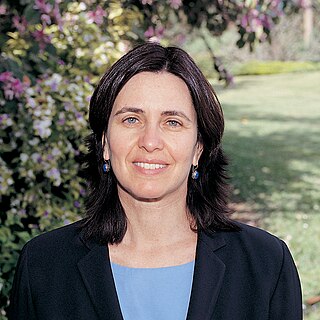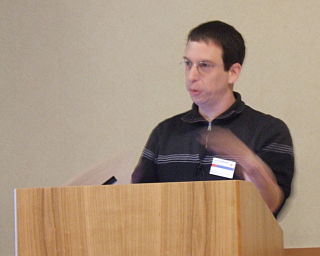Related Research Articles

David Lee Chaum is an American computer scientist and cryptographer. He is known as a pioneer in cryptography and privacy-preserving technologies, and widely recognized as the inventor of digital cash. His 1982 dissertation "Computer Systems Established, Maintained, and Trusted by Mutually Suspicious Groups" is the first known proposal for a blockchain protocol. Complete with the code to implement the protocol, Chaum's dissertation proposed all but one element of the blockchain later detailed in the Bitcoin whitepaper.
In cryptography, a Feistel cipher is a symmetric structure used in the construction of block ciphers, named after the German-born physicist and cryptographer Horst Feistel who did pioneering research while working for IBM (USA); it is also commonly known as a Feistel network. A large proportion of block ciphers use the scheme, including the Data Encryption Standard (DES). The Feistel structure has the advantage that encryption and decryption operations are very similar, even identical in some cases, requiring only a reversal of the key schedule. Therefore, the size of the code or circuitry required to implement such a cipher is nearly halved.
ID-based encryption, or identity-based encryption (IBE), is an important primitive of ID-based cryptography. As such it is a type of public-key encryption in which the public key of a user is some unique information about the identity of the user. This means that a sender who has access to the public parameters of the system can encrypt a message using e.g. the text-value of the receiver's name or email address as a key. The receiver obtains its decryption key from a central authority, which needs to be trusted as it generates secret keys for every user.
The Gödel Prize is an annual prize for outstanding papers in the area of theoretical computer science, given jointly by European Association for Theoretical Computer Science (EATCS) and the Association for Computing Machinery Special Interest Group on Algorithms and Computational Theory. The award is named in honor of Kurt Gödel. Gödel's connection to theoretical computer science is that he was the first to mention the "P versus NP" question, in a 1956 letter to John von Neumann in which Gödel asked whether a certain NP-complete problem could be solved in quadratic or linear time.

Shafrira "Shafi" Goldwasser is an Israeli-American computer scientist and winner of the Turing Award in 2012. She is the RSA Professor of Electrical Engineering and Computer Science at MIT, a professor of mathematical sciences at the Weizmann Institute of Science, Israel, co-founder and chief scientist of Duality Technologies and the director of the Simons Institute for the Theory of Computing in Berkeley, CA.
Provable security refers to any type or level of computer security that can be proved. It is used in different ways by different fields.

Silvio Micali is an Italian computer scientist at MIT Computer Science and Artificial Intelligence Laboratory and a professor of computer science in MIT's Department of Electrical Engineering and Computer Science since 1983. His research centers on the theory of cryptography and information security.
The Diffie–Hellman problem (DHP) is a mathematical problem first proposed by Whitfield Diffie and Martin Hellman in the context of cryptography. The motivation for this problem is that many security systems use one-way functions: mathematical operations that are fast to compute, but hard to reverse. For example, they enable encrypting a message, but reversing the encryption is difficult. If solving the DHP were easy, these systems would be easily broken.
In computational complexity theory, a computational hardness assumption is the hypothesis that a particular problem cannot be solved efficiently. It is not known how to prove (unconditional) hardness for essentially any useful problem. Instead, computer scientists rely on reductions to formally relate the hardness of a new or complicated problem to a computational hardness assumption about a problem that is better-understood.

Dan Boneh is an Israeli-American professor in applied cryptography and computer security at Stanford University.

Moni Naor is an Israeli computer scientist, currently a professor at the Weizmann Institute of Science. Naor received his Ph.D. in 1989 at the University of California, Berkeley. His advisor was Manuel Blum.
Lattice-based cryptography is the generic term for constructions of cryptographic primitives that involve lattices, either in the construction itself or in the security proof. Lattice-based constructions are currently important candidates for post-quantum cryptography. Unlike more widely used and known public-key schemes such as the RSA, Diffie-Hellman or elliptic-curve cryptosystems, which could, theoretically, be easily attacked by a quantum computer, some lattice-based constructions appear to be resistant to attack by both classical and quantum computers. Furthermore, many lattice-based constructions are considered to be secure under the assumption that certain well-studied computational lattice problems cannot be solved efficiently.
Identity-based cryptography is a type of public-key cryptography in which a publicly known string representing an individual or organization is used as a public key. The public string could include an email address, domain name, or a physical IP address.
Post-quantum cryptography refers to cryptographic algorithms that are thought to be secure against an attack by a quantum computer. As of 2020, this is not true for the most popular public-key algorithms, which can be efficiently broken by a sufficiently strong quantum computer. The problem with currently popular algorithms is that their security relies on one of three hard mathematical problems: the integer factorization problem, the discrete logarithm problem or the elliptic-curve discrete logarithm problem. All of these problems can be easily solved on a sufficiently powerful quantum computer running Shor's algorithm. Even though current, publicly known, experimental quantum computers lack processing power to break any real cryptographic algorithm, many cryptographers are designing new algorithms to prepare for a time when quantum computing becomes a threat. This work has gained greater attention from academics and industry through the PQCrypto conference series since 2006 and more recently by several workshops on Quantum Safe Cryptography hosted by the European Telecommunications Standards Institute (ETSI) and the Institute for Quantum Computing.
Amos Fiat is an Israeli computer scientist, a professor of computer science at Tel Aviv University. He is known for his work in cryptography, online algorithms, and algorithmic game theory.
Mordechai M. "Moti" Yung is a cryptographer and computer scientist known for his work on cryptovirology and kleptography.
In cryptography, server-based signatures are digital signatures in which a publicly available server participates in the signature creation process. This is in contrast to conventional digital signatures that are based on public-key cryptography and public-key infrastructure. With that, they assume that signers use their personal trusted computing bases for generating signatures without any communication with servers.
Jonathan Katz is a professor in the Department of Computer Science of the Volgenau School of Engineering at George Mason University, where he also holds the title of Eminent Scholar in Cybersecurity. In 2013–2019 he was director of the Maryland Cybersecurity Center at the University of Maryland. He conducts research on cryptography and cybersecurity.
Antoine Joux is a French cryptographer, one of the three 2013 Gödel Prize laureates., specifically cited for his paper A one round protocol for tripartite Diffie-Hellman.

Amit Sahai is an American computer scientist. He is a professor of computer science at UCLA and the director of the Center for Encrypted Functionalities.
References
- ↑ Department faculty, UC Davis Computer Science, retrieved 2013-05-31.
- 1 2 3 Curriculum vitae, retrieved 2013-06-01.
- ↑ Matthew K. Franklin at the Mathematics Genealogy Project
- ↑ Journal of Cryptology Editorial Board, International Association for Cryptologic Research, retrieved 2013-06-01.
- ↑ ACM Group Presents Gödel Prize for Advances in Cryptography: Three Computer Scientists Cited for Innovations that Improve Security Archived 2013-06-01 at the Wayback Machine , Association for Computing Machinery, May 29, 2013.